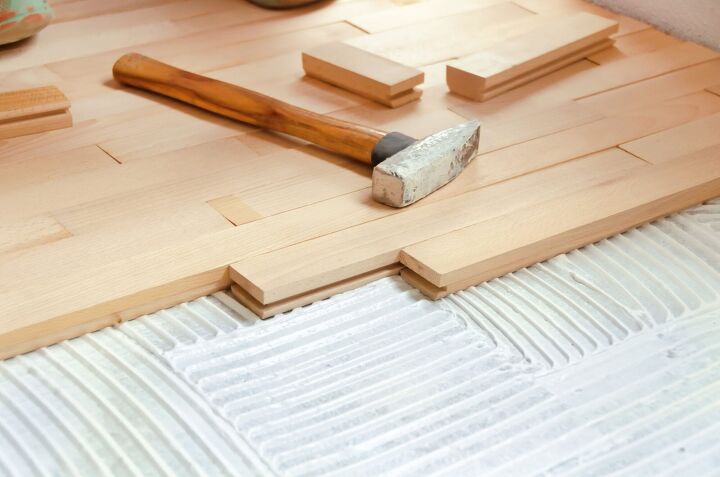3/8" Vs. 3/4" Hardwood Flooring: Which One Is Better?

Undeniably, hardwood floors can add appeal, style, warmth, and value to your home. Not to mention, they come in a wide array of options and can complement virtually any décor style. Hardwood flooring is also easier to maintain than carpeting, more durable, harbors fewer allergens, and can be refinished as needed.
However, when it comes to choosing hardwood flooring, one of the major decisions you’ll make is between solid wood and engineered wood. Beyond that, you’ll also need to pick a thickness – such as 5/8 inch vs. ¾ inch for solid wood, or 3/8 inch vs. ½ inch for engineered wood. The standard thickness for solid wood flooring is ¾ inch.
Whereas, for engineered wood, it’s most recommended to choose a thickness between ¾ inch and 5/8 inch, though the thinnest engineered wood is 3/8-inch thick.
Ultimately, the choice between 3/8-inch and ¾-inch hardwood flooring depends on whether or not you’re using solid hardwood or engineered hardwood. With that said, you’re always going to get more bang for your buck you opt for solid hardwood floors at 3/4-inch thick.
However, if there are any construction issues that make this option challenging, or you’re working over top of a cement subfloor, you may want to opt for engineered wood.
With that said, let’s take a look at the differences between solid and engineered wood, the various thicknesses available, and why choosing the right hardwood floor thickness is so crucial.
Do You Need to Hire a Flooring Contractor?
Get free, zero-commitment quotes from pro contractors near you.

Solid Hardwood vs. Engineered Hardwood
Solid wood is the original form of hardwood flooring and is still popular among many homeowners today. In most cases, it is solid throughout and is made from hardwood species like oak, maple, or walnut. Standard solid hardwood is typically between 5/16 inch and ¾ inch thick. When compared to engineered wood planks, solid wood boards are narrower and have together seams. You can also purchase the boards pre-finished or unfinished, depending on your preferences.
Engineered wood is designed to look like solid hardwood, but is actually made out of a substrate (also known as a subfloor) of plywood. This subfloor is covered with a reasonably thin layer of hardwood that is secured to the surface. Engineered wood flooring is usually either 3/8 inch thick or ½ inch thick, and is broader than solid hardwood. Unlike solid hardwood, engineered hardwood has few color options and comes pre-finished.
Though, you’ll usually find that engineered hardwood is more affordable than solid hardwood.
Another crucial difference between solid hardwood and engineered hardwood is that the solid variety is much easier to sand and refinish. If the top layer, or veneer layer, of engineered wood flooring is too thin, refinishing may be impossible. In this case, solid wood flooring boards are much easier to work with. Engineered flooring is best suited for apartments and basements with concrete subfloors. Though, they may also be installed on top of existing floors where you don’t want to remove the old material.
Engineered wood does not raise the floor height as much as solid boards, which makes it ideal in these types of situations. Solid hardwood is typically placed over several levels of supporting plywood, whereas, engineered boards can be adhered directly to concrete.
Engineered Wood Flooring Thickness
The top layer of engineered hardwood is a veneer, or wear, layer. Underneath the veneer layer is the “core,” or “backing.” The thicknesses of both of these layers will vary based on the manufacturer, but, it’s important that the core is thicker than the veneer layer.
With that said, it’s recommended to choose an engineered wood flooring that has an overall thickness between ¾ inch and 5/8 inch. When you break that down, the veneer layer should be 3/16 inch thick, and the core should have a thickness of 9- or 11-ply (plywood).
Of course, you can opt for engineered flooring that is less thick, but these are lower grades that will often impact the installation method. The thinnest option for engineered hardwood is 3/8 inch thickness. Since it’s so thin, nails are required to secure the boards in place. Whereas, thicker boards can be glued down, which is more visually appealing and requires less work.
Solid Wood Flooring Thickness
The most traditional thickness for solid hardwood flooring is ¾ inch, though you may also find some boards that are 1 inch thick. Even if they offer long lifespans, these boards may not always be the best choice. For example, if thick solid hardwood boards are exposed to a significant amount of moisture, they can warp or buckle. This issue can also arise if the flooring is installed improperly.
When you want to install thick hardwood over concrete, a wood substrate floor must exist beneath it. Solid hardwood flooring also comes in 1/2 inch and 5/8 inch thicknesses, and choosing the right size depends on how high you want your floor to be.
Meanwhile, thinner solid hardwood floor planks are usually less susceptible to moisture damage and more versatile. Though, you’ll likely notice less comfort underfoot with thin solid hardwood than thick.
3/8” vs. 3/4” Hardwood Flooring?
If you’ve found yourself torn between 3/8 inch and ¾ inch thick hardwood flooring, first consider the type of hardwood you want: solid or engineered? Both types can be found in a variety of thicknesses. Regardless of the type of hardwood that you choose, the main difference between 3/8 inch thickness and ¾ inch thickness is the number of refinishings you’ll be able to do.
With 3/8 inch solid hardwood flooring, the boards are thinner and you won’t be able to sand and refinish as many times as you would with the thicker, ¾ inch boards. Eventually, you’ll have to replace the entire flooring. With engineered hardwood, though, the product is pre-finished, has a core and veneer layer, and is more cost-effective.
However, you’re always going to get more bang for your buck when you go with the thicker, solid hardwood. You’ll enjoy more durability and more refinishing possibilities over a longer period of time. In most cases, the thinner, engineered products have thin veneer layers and can be unpredictable in terms of stability. Your decision ultimately comes down to whether or not you want to spend a couple of extra bucks on something you know is going to last, or purchasing something low cost that you may regret down the line.
Why Hardwood Floor Thickness is Important
Purchasing hardwood flooring can be confusing, especially with so many lengths, widths, species, finishes, and stains to choose from. However, there’s one option that you may see less often than the others: thickness. While some sellers don’t even offer hardwood flooring thickness options, others do but don’t explain the differences and why it matters.
In particular, the thickness of solid hardwood flooring matters when you plan to install it over a wooden subfloor that has questionable integrity. For instance, if the subfloor isn’t as stable as you would prefer, a thicker hardwood would be best. Thicker hardwood planks provide structural integrity and, in some cases, can facilitate climate control. Many homeowners suggest that their homes have better insulation with thicker hardwood flooring.
Engineered hardwood, on the other hand, has two separate thicknesses to consider: the thickness of the entire plank and the thickness of the veneer layer. A thicker veneer layer will typically only impact a floor if it’s damaged. The thinner the veneer layer, the more susceptible it is to being scratched through and exposing the plies underneath. Also, with thicker never layers, you can sand easily to repair. A thinner layer won’t survive as many times being sanded over and over again.
Do You Need to Hire a Flooring Contractor?
Get free, zero-commitment quotes from pro contractors near you.

Related Questions
How thick should hardwood floors be?
Generally speaking, the thicker the better with hardwood floors. The greatest and most common thickness for solid hardwood flooring is ¾ inch. Although these boards are more expensive than the thinner options, they will be more durable and have a longer life expectancy.
What is the best hardwood for flooring?
Cherry, bamboo, ebony, and live oak are among the most durable options for solid hardwood flooring. These species are incredibly hard, wear well, and are more resistant to minor damage than alternatives.

Jessica considers herself a home improvement and design enthusiast. She grew up surrounded by constant home improvement projects and owes most of what she knows to helping her dad renovate her childhood home. Being a Los Angeles resident, Jessica spends a lot of her time looking for her next DIY project and sharing her love for home design.
More by Jessica Stone



























